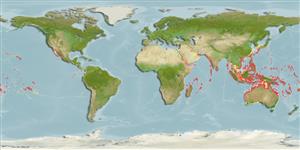Common names from other countries
>
Blenniiformes (Blennies) >
Blenniidae (Combtooth blennies) > Salariinae
Etymology: Ecsenius: Greek, exenios, -os, -on = uncontrolled, immoderate.
Environment: milieu / climate zone / depth range / distribution range
นิเวศวิทยา
เกี่ยวกับทะเล,น้ำเค็ม เกี่ยวกับหินโสโครก; ระดับความลึก 2 - 40 m (Ref. 30874). Tropical
Indo-Pacific: Gulf of Aqaba and southeast coast of Africa to the Marquesan Islands.
ขนาด / น้ำหนัก / Age
Maturity: Lm ? range ? - ? cm
Max length : 13.0 cm TL เพศผู้/กระเทย; (Ref. 2334)
Short description
เครื่องมือที่ใช้ในการแยกชนิดสัตว์,สิ่งมีชีวิตออกจากกัน | สัณฐานวิทยา | ความยาวต่างๆ
เงี่ยงครีบหลัง (รวม) : 13 - 14; ก้านครีบอ่อนที่หาง (รวม) : 19 - 21; เงี่ยงครีบก้น: 2; ก้านครีบอ่อนที่ก้น: 20 - 23. Golden orange in color; black spot around anus; anterior part of dorsal fin with narrow dark margin (Ref. 4404). Indonesian form grey or greenish to golden-yellow. Tail long in adults (Ref. 48636).
Adults inhabit coral reefs (Ref. 9710), from clear coastal to outer reef walls, usually where currents are moderate (Ref. 48636). They swim 2 to 3 m above the benthos, feeding on plankton (Ref. 94105). During the orange-yellow phase, they are observed to school with Pseudanthias squamipinnis which they resemble in color. Individuals of Ecsenius midas can change color quickly from when on the bottom to swimming in open water to match the colors of the fishes they mix with (Ref. 48636). They also socially mimic their swimming behavior and also of Pseudanthias huchtii and Lepidozygus tapeinosomoa (Ref. 90102). Reported to feed on zooplankton (Ref. 37816). Oviparous. Eggs are demersal and adhesive (Ref. 205), and are attached to the substrate via a filamentous, adhesive pad or pedestal (Ref. 94114). Larvae are planktonic, often found in shallow, coastal waters (Ref. 94114). Minimum depth reported taken from Ref. 9710.
Life cycle and mating behavior
Maturities | การสืบพันธุ์ | Spawnings | Egg(s) | Fecundities | ตัวอ่อน
Oviparous, distinct pairing (Ref. 205).
Springer, V.G., 1988. The Indo-Pacific blenniid fish genus Ecsenius. Smithson. Contrib. Zool. (465):134 p. (Ref. 5296)
IUCN Red List Status (Ref. 130435)
CITES (Ref. 128078)
Not Evaluated
Threat to humans
Harmless
Human uses
การประมง: การค้า; สถานที่แสดงสัตว์และพืชน้ำ: การค้า
เครื่องมือ
Special reports
Download XML
แหล่งที่มาจากอินเตอร์เน็ต
Estimates based on models
Preferred temperature (Ref.
115969): 24.6 - 29, mean 27.7 (based on 716 cells).
Phylogenetic diversity index (Ref.
82804): PD
50 = 0.5000 [Uniqueness, from 0.5 = low to 2.0 = high].
Bayesian length-weight: a=0.00741 (0.00335 - 0.01640), b=3.02 (2.83 - 3.21), in cm Total Length, based on LWR estimates for this (Sub)family-body shape (Ref.
93245).
ระดับชั้นอาหาร (Ref.
69278): 2.6 ±0.29 se; based on food items.
ความสามารถในการกลับคืนสู่ปกติ (Ref.
120179): ความสูง, เวลาต่ำสุดที่จะทำให้ประชากรเพิ่มขึ้นเป็น 2 เท่าใช้เวลาน้อยกว่า 15 เดือน (Preliminary K or Fecundity.).
Fishing Vulnerability (Ref.
59153): Low vulnerability (10 of 100).
